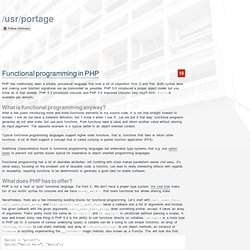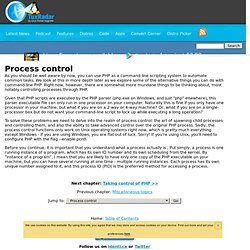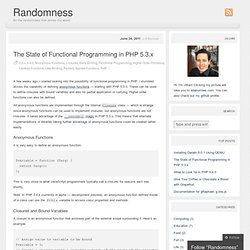

Javascript and PHP Image Editor. Functional programming in PHP - /usr/portage βeta — Lars Strojny. Functional programming in PHP 16 PHP has traditionally been a simple, procedural language that took a lot of inspiration from C and Perl.

Both syntax wise and making sure function signatures are as convoluted as possible. PHP 5.0 introduced a proper object model but you know all of that already. PHP 5.3 introduced closures and PHP 5.4 improved closures very much (hint: $this is available per default). What is functional programming anyway? After a few years introducing more and more functional elements to my source code, it is not that straight forward to answer. Typical functional programming languages support higher order functions, that is, functions that take or return other functions. Additional characteristics found in functional programming languages are elaborated type systems that e.g. use option types to prevent null pointer issues typical for imperative or object oriented programming languages.
What does PHP has to offer? Methods for asynchronous processes in PHP - Impracticality. Use_cases [Gearman] Practical PHP Programming. As you should be well aware by now, you can use PHP as a command-line scripting system to automate common tasks.

We look at this in more depth later as we explore some of the alternative things you can do with command-line PHP. Right now, however, there are somewhat more mundane things to be thinking about, most notably controlling processes through PHP. Given that PHP scripts are executed by the PHP parser (php.exe on Windows, and just "php" elsewhere), this parser executable file can only run in one processor on your computer.
Naturally this is fine if you only have one processor in your machine, but what if you are on a 2-way or 4-way machine? Or, what if you are on a single-processor box but do not want your command-line script to lock up while executing a long operation? To solve these problems we need to delve into the realm of process control: the art of spawning child processes and controlling them, and also the ability to take advanced control over the original PHP process. The Mysteries Of Asynchronous Processing With PHP – Part 1: Asynchronous Benefits, Task Identification and Implementation Methods. Imagine a world where clients will give up on receiving responses from your application in mere seconds, where failed emails will give rise to complaints and lost business, where there exist tasks that must be performed regularly regardless of how many requests your application receives.

This is not a fantasy world, it’s reality. In the real world your application must be responsive, reliable and capable of recovery from errors. These are obvious needs but all too often applications fail to realise them. Sometimes, developers even fail to realise they should even be concerned about them. To offer an opening real-world example, I’ll borrow from a recent discussion I had concerning the Pubsubhubbub Protocol. In that discussion, the original poster was having a problem. Why was the five second timeout being exceeded by the Subscriber? Here’s the problem in a nutshell. What is Asynchronous Processing? Implementing asynchronous processing can take a few directions: Multithreading - php process forking and get the child process id.
The State of Functional Programming in PHP 5.3.x « Randomness. A few weeks ago, I started looking into the possibility of functional programming in PHP.

I stumbled across the capability of defining anonymous functions — starting with PHP 5.3.0. These can be used to define closures with bound variables and also for partial application or currying. Higher order functions can also be defined. All anonymous functions are implemented through the internal Closure class — which is strange since anonymous functions can be used to implement closures, but anonymous functions are not closures. It takes advantage of the __invoke() magic in PHP 5.3.x. Anonymous Functions It is very easy to define an anonymous function: $variable = function ($arg) { return $arg+1; }; This is very close to what JavaScript programmers typically call a closure, for reasons we’ll see shortly.
Note: In PHP 5.4.x (currently in alpha — development preview), an anonymous function defined inside of a class can use the $this variable to access class properties and methods. This would output: